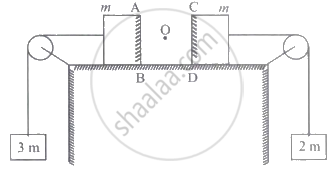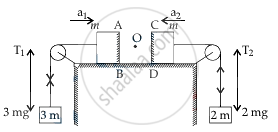Advertisements
Advertisements
Question
Two blocks each of mass m lie on a smooth table. They are attached to two other masses as shown in the figure. The pulleys and strings are light. An object O is kept at rest on the table. The sides AB and CD of the two blocks are plane and made reflecting. The acceleration of two images formed in those two reflecting surfaces with respect to each other is ______.

Options
`(13g)/6`
`(11g)/6`
`(17g)/6`
`(19g)/6`
Solution
Two blocks each of mass m lie on a smooth table. They are attached to two other masses as shown in the figure. The pulleys and strings are light. An object O is kept at rest on the table. The sides AB and CD of the two blocks are plane and made reflecting. The acceleration of two images formed in those two reflecting surfaces with respect to each other is `underlinebb((17g)/6).`
Explanation:

Let the acceleration of AB is a1 and the acceleration of CO be a2.
For AB
3mg - T1 = 3ma1 ..........(i)
T1 = ma1 ............(ii)
From (i) and (ii),
3mg = 4ma1
⇒ `a_1 = (3mg)/(4m)`
⇒ `a_1 = (3g)/4`
For CD
2mg - T2 = 2ma2 .................(iii)
T2 = ma2 ................(iv)
From equation (iii) and (iv),
2mg = 3ma2
⇒ `a_2 = (2mg)/(3m)`
⇒ `a_2 = (2g)/3`
Now, acceleration of image in AB mirror.
`(a_{AB}) = 2a_1`
= `2 xx (3g)/4`
= `(3g)/2`
Acceleration of image in mirror CD.
`(a_{CD}) = 2a_2`
= `2 xx (2g)/3`
= `(4g)/3`
So, relative acceleration = a1 + a2
= `(3g)/2 + (4g)/3`
= `(9g + 8g)/6`
= `(17g)/6`
